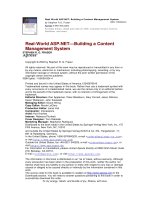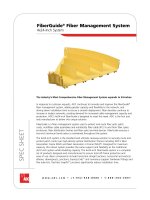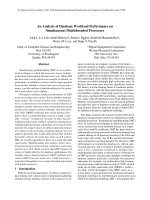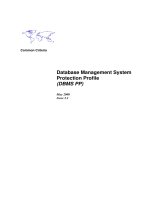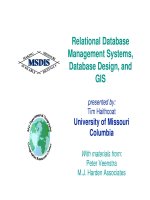Database Management System Protection Profile (DBMS PP) pot
Bạn đang xem bản rút gọn của tài liệu. Xem và tải ngay bản đầy đủ của tài liệu tại đây (645.83 KB, 48 trang )
Common Criteria
Database Management System
Protection Profile
(DBMS PP)
May 2000
Issue 2.1
Version
Authors,
Reviewers
Change Summary
2.1
Primary Author:
Howard Smith
1. Address comments raied by evaluators/certifier
2.0
Primary Author:
Howard Smith
1. Updated to use functional packages for authentication
Reviewers:
Steve Hill (Logica),
Duncan Harris,
Rajiv Sinha
2. Updates for CEM 1.0 Compliance
3. Updates for CC 2.1/ISO 15408 Compliance
4. Renamed to Database Management System Protection Profile (DBMS.PP)
1.0
Primary Author:
Jeff DeMello
1. Release for 1998 NISSC.
0.6
Primary Author:
Steve Pannifer (Logica)
1. Address comments raised by evaluators
Reviewers: Rae Burns,
Steve Hill (Logica)
0.5
Primary Author:
Jeff DeMello
1. Incorporated Rae Burns and Steve Hill comments
2. Reformatted FrameMaker book file.
Reviewers: Rae Burns,
Steve Hill (Logica)
0.4
Primary Author:
Jeff DeMello
Reviewers: Rae Burns,
Howard Smith
1. Updated to be compliant with CC v2.0 Final.
2. Replaced FAU_STG.4 with FAU_STG.3.
3. Added table for required management events.
4. Updated IT Threat Agents definitions for Outsiders, System Users, and Database Users.
5. Updated O.INSTALL a) to make wording consistent with b)
0.3
Primary Author:
Jeff DeMello
1. Added new requirements (FAU_STG.4, FIA_AFL.1, FIA_SOS.1, FIA_UAU.2, FPT_RVM.1,
FPT_SEP.1, FTA_TSE.1), and updated associated tables.
Reviewers: Howard
Smith, Rae Burns
2. Updated to be compliant with CC v2.0 Semi-Final.
3. Added Cover, Revisions, Table of Contents, References, and Glossary.
4. Removed T.BADMEDIA, renamed T.ABUSE and T.PHYSICAL, O.ACCESS.DATA,
O.ACCESS.REUSE.
5. Removed PP Application Notes.
6. Integrated Howard Smith & Rae Burns comments
0.2
Primary Author:
Howard Smith
1. Second Issue
Reviewers: Jeff DeMello,
Rae Burns
0.1
Primary Author:
Howard Smith (Logica)
1. First Issue
Reviewers: Rae Burns
ii
May 2000
Issue 2.1
Contents
May 2000
1 Introduction........................................................................... 5
1.1 Identification of Protection Profile................................................. 5
1.2 Protection Profile Overview........................................................... 5
2 Target of Evaluation (TOE) Description ............................. 7
2.1 Product Type .................................................................................. 7
2.2 General Features - Core Requirements .......................................... 7
2.3 Authentication Packages ................................................................ 7
3 Security Environment .......................................................... 9
3.1 IT Assets......................................................................................... 9
3.2 Threats............................................................................................ 9
3.3 Organisational Security Policies .................................................. 11
3.4 Assumptions ................................................................................. 11
4 Security Objectives ............................................................ 13
4.1 TOE Security Objectives.............................................................. 13
4.2 Environmental Security Objectives.............................................. 14
5 Security Requirements ...................................................... 19
5.1 TOE IT Security Functional Requirements - Core Requirements 19
5.2 TOE IT Security Requirements - OS Authentication................... 27
5.3 TOE IT Security Requirements - Database Authentication ......... 27
5.4 IT Assurance Requirements ......................................................... 29
5.5 Security Requirements for the IT Environment - Core Requirements
May 2000
Issue 2.1
iii
Contents
May 2000
29
5.6 Security Requirements for the IT Environment - OS Authentication
30
5.7 Security Requirements for the IT Environment Database Authentication ............................................................... 30
5.8 Minimum Strength of Function .................................................... 30
6 Rationale ..............................................................................31
6.1 Security Objectives Rationale....................................................... 31
6.2 Security Requirements Rationale - Core Services ........................ 33
6.3 Security Requirements Rationale - OS Authentication ................ 37
6.4 Security Requirements Rationale - Database Authentication....... 37
6.5 Assumptions Rationale ................................................................. 38
6.6 Strength of Functions Rationale ................................................... 39
6.7 Security Assurance Rationale ....................................................... 40
7 Application Notes................................................................41
7.1 Intended use of this PP.................................................................. 41
7.2 Functional Packages for Authentication Package
(OS Authentication) ...................................................................... 41
7.3 Functional Packages for Authentication Package
(Database Authentication)............................................................. 41
A References ..........................................................................43
B Glossary ..............................................................................45
iv
May 2000
Issue 2.1
Database Management System
Protection Profile
Common
Criteria
1
Introduction
1.1
Identification of Protection Profile
1
Title:
Database Management System Protection Profile (DBMS.PP)
2
Registration:
(to be completed by registrar)
3
Version:
2.1
4
Publication Date:
May 2000
5
Author(s):
Howard Smith
6
Sponsor:
Oracle Corporation
7
CC Version:
[CC], Version 2.1
8
Keywords:
Database, Protection Profile, TCSEC C2, ITSEC F-C2/E2,
RDBMS, O-RDBMS
9
Assurance Level:
EAL3
1.2
Protection Profile Overview
10
This protection profile specifies security requirements for database management systems in organisations where there are requirements for protection of the confidentiality (on a “need to know” basis), integrity and availability of information stored in the
database. Typically such organisations may be handling commercial, military or medical data; the unauthorised disclosure, modification or withholding of such information may have a severe impact on the operations of the organisation.
11
This PP identifies:
• a set of core requirements which all compliant databases must provide; and
• a set of authentication packages (of which one or more must be provided by a
compliant database).
12
The Core Requirements provide basic database functionality, including allowing
users to be granted the discretionary right to disclose the information to which they
have legitimate access to other users.
13
The administrators of these systems have the ability to:
• control and monitor the actions of end users to help ensure they do not abuse their
rights within the system,
• control resource consumption of individual users, and
• account for users actions.
14
The Authentication Packages provide the means to authenticate the user by:
• OS Authentication (the user is authenticated by the host OS and identified to the
database); or
May 2000
Issue 2.1
5
Common
Criteria
Database Management System
Protection Profile
• Database Authentication (the user is identified and authenticated by the RDBMS).
15
The approach of splitting Core Requirements and Authentication Packages has been
adopted to ease the maintenance of this protection profile. It is intended that future
issues of this protection profile may extend the list of authentication packages offered,
for example, to include directory based authentication.
16
Security Targets wishing to claim conformance with this protection profile must state
which authentication package are being claimed. PP conformance claims shall either
state “DBMS in OS Authentication Mode”, “DBMS in Database Authentication
Mode” or “DBMS in OS and Database Authentication Modes”.
6
May 2000
Issue 2.1
Common
Criteria
Database Management System
Protection Profile
2
Target of Evaluation (TOE) Description
2.1
Product Type
17
The product type is a “Database Management System” (DBMS).
2.2
General Features - Core Requirements
18
Typically a DBMS is used to provide many users with simultaneous access to a database.
19
A DBMS may be configured in many ways:
• a stand alone system with a single database user (e.g. a single user PC based application);
• many database users working at terminals connected to a central machine (e.g. a
traditional terminal - mainframe environment);
• a network of intelligent workstations communicating with a central server (a “client - server” architecture); or
• a network of intelligent client workstations communicating with an application
server, which in turn is communicating with the DMBS (e.g. a Web browser communicating with a Web Server which is building dynamic pages from a DBMS).
20
In each of the above configurations the data itself may reside on one server machine,
or be distributed among many independent servers.
21
In general, a DBMS is simply an application (albeit large) layered on an underlying
system (host operating system and/or network services and/or custom software) and is
usually an embedded IT component in a specific system in a defined operational environment.
22
A DBMS application may consist of one or more executable images and one or more
data files. These will be subject to the administration of underlying system rights as
for any other underlying system processes and files.
23
A DBMS may extend the security functionality of an underlying system, for example
a database could implement a very much more fine grained privilege mechanism than
the host operating system.
2.3
Authentication Packages
24
An authentication package provides the mechanism for the database to authenticate
the claimed identity of a user. Within this protection profile this may be provided by
the following two mechanisms:
• externally by the host operating system (OS Authentication). In this authentication
scheme the database relies on the host operating system to identify and authenticate a user which then provides the authenticated user identity to the database. The
database uses the provided operating system identity to establish a database iden-
May 2000
Issue 2.1
7
Common
Criteria
Database Management System
Protection Profile
tity (which may be different);
• within the database itself (Database Authentication). In this authentication scheme
the database verifies the claimed user identity by using its own authentication
mechanism.
25
8
At least one of the above authentication services must be provided by a compliant
database.
May 2000
Issue 2.1
Common
Criteria
Database Management System
Protection Profile
3
Security Environment
26
This section identifies the IT assets protected by the TOE. It also identifies the threats
to those IT assets, the organisational security policies supported by the TOE, and the
assumptions for secure usage of the TOE.
3.1
IT Assets
27
The IT assets requiring protection consist of the information stored within the DBMS,
the confidentiality, integrity or availability of which could be compromised. The IT
assets are:
DB Objects
Database objects and the data contained within those database objects. DB objects may
be aggregations of data contained in other database objects.
DB Control Data
Database control data used by the DBMS to organize and protect the database objects.
DB Audit Data
Database audit data generated by the DBMS during operation.
3.2
Threats
28
The assumed threats to TOE security, along with the threat agents which might instigate these threats, are specified below. Each threat statement identifies a means by
which the TOE and its underlying system might be compromised.
29
These threats will be countered by:
a)
technical security measures provided by the TOE, in conjunction with
b)
technical security measures provided by an underlying system, and
c)
non-technical operational security measures (personnel, procedural and physical
measures) in the environment.
3.2.1
Threat Agents
30
The threat agents are:
Outsiders
Persons who are not authorised users of the underlying system (operating system and/
or network services and/or custom software).
Database Users
Persons who are authorised users of the TOE.
System Users
Persons who are authorised users of the underlying system. System Users may be:
a)
those persons who are not Database Users; or
b)
those persons who are Database Users.
External Events
Interruptions to operations arising from failures of hardware, power supplies, storage
media, etc.
3.2.2
Threats countered by the TOE
31
Threat agents can initiate the following types of threats against the DBMS. The fol-
May 2000
Issue 2.1
9
Common
Criteria
Database Management System
Protection Profile
lowing threats are countered by the DBMS.
T.ACCESS
Unauthorised Access to the Database. An outsider or system user who is not (currently)
an authorised database user accesses the DBMS. This threat includes: Impersonation a person, who may or may not be an authorised database user, accesses the DBMS, by
impersonating an authorised database user (including an authorised user impersonating
a different user who has different - possibly more privileged - access).
T.DATA
Unauthorised Access to Information. An authorised database user accesses information
contained within a DBMS without the permission of the database user who owns or
who has responsibility for protecting the data.
32
This threat includes unauthorised access to DBMS information, residual information
held in memory or storage resources managed by the TOE, or DB control data.
T.RESOURCE
Excessive Consumption of Resources. An authenticated database user consumes global
database resources, in a way which compromises the ability of other database users to
access the DBMS.
33
This represents a threat to the availability of the information held within a DBMS. For
example, a database user could perform actions which could consume excessive
resources, preventing other database users from legitimately accessing data, resources
and services in a timely manner. Such attacks may be malicious, inconsiderate or
careless, or the database user may simply be unaware of the potential consequences of
his actions. The impact of such attacks on system availability and reliability would be
greatly amplified by multiple users acting concurrently.
T.ATTACK
Undetected Attack. An undetected compromise of the DBMS occurs as a result of an
attacker (whether an authorised user of the database or not) attempting to perform
actions that the individual is not authorised to perform.
34
This threat is included because, whatever countermeasures are provided to address the
other threats, there is still a residual threat of a violation of the security policy occurring by attackers attempting to defeat those countermeasures.
T.ABUSE.USER
Abuse of Privileges. An undetected compromise of the DBMS occurs as a result of a
database user (intentionally or otherwise) performing actions the individual is
authorised to perform.
35
This threat is included because, whatever countermeasures are provided to address the
other threats, there is still a residual threat of a violation of the security policy occurring, or the database being placed at risk, as a result of actions taken by authorised
database users. For example a database user may grant access to a DB object they are
responsible for to another database user who is able to use this information to perform
a fraudulent action.
36
Note that this threat does not extend to highly trusted database users: see the assumption A.MANAGE below.
10
May 2000
Issue 2.1
Common
Criteria
Database Management System
Protection Profile
3.2.3
Threats countered by the Operating Environment
T.OPERATE
Insecure Operation. Compromise of the database may occur because of improper
configuration, administration, and/or operation of the composite system.
T.CRASH
Abrupt Interruptions. Abrupt interruptions to the operation of the TOE may cause
security related data, such as database control data and audit data, to be lost or corrupted.
Such interruptions may arise from human error (see also T.OPERATE) or from failures
of software, hardware, power supplies, or storage media.
T.PHYSICAL
Physical Attack. Security-critical parts of the TOE or the underlying operating system
and/or network services may be subjected to physical attack which could compromise
security.
3.3
Organisational Security Policies
P.ACCESS
Access to DB objects are determined by:
a)
b)
the identity of the database subject attempting the access; and
c)
the DB object access privileges to the DB object held by the database subject; and
d)
the database administrative privileges of the database subject; and
e)
37
the owner of the DB object; and
the resources allocated to the subject.
Note that this policy includes the following:
a)
b)
Discretionary Access Control - DB object owners may grant other database users
access to or control over their DB objects on a discretionary basis.
c)
P.ACCOUNT
Ownership - DB object owners are responsible for their DB objects; and
Resources - Database users are authorised to use only their allocated resources.
Database users are accountable for:
a)
operations on objects as configured by the owner of the object; and
b)
actions configured by database administrators.
3.4
Assumptions
38
The TOE is dependent upon both technical IT and operational aspects of its environment.
3.4.1
TOE Assumptions
A.TOE.CONFIG
The TOE is installed, configured, and managed in accordance with its evaluated
configuration.
May 2000
Issue 2.1
11
Common
Criteria
Database Management System
Protection Profile
3.4.2
Underlying System Assumptions
3.4.2.1
Physical Assumptions
A.PHYSICAL
The processing resources of the TOE and the underlying system are located within
controlled access facilities which prevents unauthorised physical access by Outsiders,
System users and Database Users.
3.4.2.2
Configuration Assumptions
A.SYS.CONFIG
The underlying system (operating system and/or secure network services and or custom
software) is installed, configured, and managed in accordance with its secure
configuration.
A.ACCESS
The underlying system is configured such that only the approved group of individuals
may obtain access to the system.
A.MANAGE
There will be one or more competent individuals assigned to manage the TOE and the
underlying system and the security of the information it contains who can be trusted
not to abuse their privileges.
3.4.2.3
Connectivity Assumptions
A.PEER
Any other IT components with which the TOE communicates are assumed to be under
the same management control and operate under the same security policy.
A.NETWORK
When required by the TOE, in a distributed environment the underlying network
services are assumed to be based on secure communications protocols which ensure
the authenticity of users.
12
May 2000
Issue 2.1
Database Management System
Protection Profile
Common
Criteria
4
Security Objectives
39
This section first describes the IT security objectives of the TOE and the threats and
policies they address. Then the requirements on the operational environment needed
to support the TOE IT objectives are presented.
4.1
TOE Security Objectives
40
This section defines the IT security objectives that are to be satisfied by the TOE in
combination with the IT security environment. Table 1 correlates the TOE security
objectives to each of the threats and security policies, showing that each threat is
countered by at least one IT security objective, and that each security policy is satisfied by at least one IT security objective. A YES indicates that the identified IT security objective is relevant to the identified threat or security policy.
Threat/Policy
O.I&A.TOE
O.ACCESS
T.ACCESS
YES
YES
T.DATA
YES
YES
T.RESOURCE
YES
YES
T.ATTACK
YES
YES
YES
YES
T.ABUSE.USER
YES
YES
YES
YES
P.ACCESS
YES
O.RESOURCE
O.ADMIN.TOE
YES
YES
YES
YES
YES
P.ACCOUNT
O.AUDIT
YES
YES
YES
Table 1: Correlation of Threats and Policies to TOE Security Objectives
41
Chapter 6 provides the rationale as to why the identified security objectives are suitable to counter the identified threats.
O.ACCESS
The TOE must provide end-users and administrators with the capability of controlling
and limiting access, by identified individuals, or grouping of individuals, to the data or
resources they own or are responsible for, in accordance with the P.ACCESS security
policy. To this end the TOE has the following more specific objectives:
O.ACCESS.OBJECTS
O.ACCESS.CONTROL
May 2000
Issue 2.1
The TOE must prevent the unauthorised or undesired
disclosure, entry, modification, or destruction of data and
database objects, database views, and database control and
audit data.
The TOE must allow database users who own or are responsible
for data to control the access to that data by other authorised
database users.
13
Database Management System
Protection Profile
Common
Criteria
O.ACCESS.RESIDUAL
The TOE must prevent unauthorised access to residual data
remaining in objects and resources following the use of those
objects and resources.
O.RESOURCE
The TOE must provide the means of controlling the consumption of database resources
by authorised users of the TOE.
O.I&A.TOE
The TOE, with or without support from the underlying system, must provide the means
of identifying and authenticating users of the TOE.
42
Note that this security objective explicitly allows identification and authentication of
database users to be performed either by the TOE or by the underlying system.
O.AUDIT
The TOE must provide the means of recording security relevant events in sufficient
detail to help an administrator of the TOE to:
a)
detect attempted security violations, or potential misconfiguration of the TOE
security features that would leave the database open to compromise; and
b)
hold individual database users accountable for any actions they perform that are
relevant to the security of the database in accordance with P.ACCOUNT.
O.ADMIN.TOE
The TOE, where necessary in conjunction with the underlying system, must provide
functions to enable an authorised administrator to effectively manage the TOE and its
security functions, ensuring that only authorised administrators can access such
functionality.
4.2
Environmental Security Objectives
43
The following IT security objectives are to be satisfied by the environment in which
the TOE is used.
O.ADMIN.ENV
The TOE, where necessary in conjunction with the underlying system, must provide
functions to enable an authorised administrator to effectively manage the TOE and its
security functions, ensuring that only authorised administrators can access such
functionality.
O.FILES
The underlying system must provide access control mechanisms by which all of the
DBMS-related files and directories (including executables, run-time libraries, database
files, export files, redo log files, control files, trace files, and dump files) may be
protected from unauthorised access.
O.I&A.ENV
The underlying operating system must provide a means of identifying and
authenticating users when required by the TOE to reliably identify authenticated users.
O.SEP
The underlying operating system must provide the means to isolate the TOE Security
Functions (TSF) and assure that TSF components cannot tampered with. The TSF
components are 1) the files used by the DBMS to store the database and 2) the TOE
processes managing the database.
44
The following non-IT security objectives are to be satisfied by procedural and other
14
May 2000
Issue 2.1
Common
Criteria
Database Management System
Protection Profile
measures taken within the TOE environment.
O.INSTALL
Those responsible for the TOE must ensure that:
a)
The TOE is delivered, installed, managed, and operated in accordance with the
operational documentation of the TOE, and
b)
The underlying system is installed and operated in accordance with its operational
documentation. If the system components are certified they should be installed
and operated in accordance with the appropriate certification documentation.
O.PHYSICAL
Those responsible for the TOE must ensure that those parts of the TOE that are critical
to the security policy are protected from physical attack.
O.AUDITLOG
Administrators of the database must ensure that audit facilities are used and managed
effectively. These procedures shall apply to the database audit trail and/or the audit trail
for the underlying operating system and/or secure network services. In particular:
a)
Appropriate action must be taken to ensure continued audit logging, e.g. by
regular archiving of logs before audit trail exhaustion to ensure sufficient free
space.
b)
Audit logs must be inspected on a regular basis and appropriate action should be
taken on the detection of breaches of security, or events that are likely to lead to
a breach in the future.
c)
The system clocks must be protected from unauthorised modification (so that the
integrity of the audit timestamps is not compromised).
O.RECOVERY
Those responsible for the TOE must ensure that procedures and/or mechanisms are in
place to ensure that, after system failure or other discontinuity, recovery without
protection (i.e. security) compromise is obtained.
O.QUOTA
Administrators of the database must ensure that each user of the TOE is configured
with appropriate quotas that are:
a)
b)
O.TRUST
sufficiently permissive to allow the user to perform the operations for which the
user has access;
sufficiently restrictive that the user cannot abuse the access and thereby
monopolise resources.
Those responsible for the TOE must ensure that only highly trusted users have the
privilege which allows them to:
a)
b)
alter or delete any audit record in the database audit trail;
c)
create any user account or modify any user security attributes;
d)
May 2000
Issue 2.1
set or alter the audit trail configuration for the database;
authorise use of administrative privileges.
15
Database Management System
Protection Profile
Common
Criteria
O.AUTHDATA
Those responsible for the TOE must ensure that the authentication data for each user
account for the TOE as well as the underlying system is held securely and not disclosed
to persons not authorised to use that account. In particular:
a)
b)
Users shall not disclose their passwords to other individuals;
c)
O.MEDIA
The media on which the authentication data for the underlying operating system
and/or secure network services is stored shall not be physically removable from
the underlying platform by unauthorised users;
Passwords generated by the system administrator shall be distributed in a secure
manner.
Those responsible for the TOE must ensure that the confidentiality, integrity and
availability of data held on storage media is adequately protected. In particular:
a)
b)
The on-line and off-line storage media must be properly stored and maintained,
and routinely checked to ensure the integrity and availability of the security
related data.
c)
45
The on-line and off-line storage media on which database and security related
data (such as operating system backups, database backups and transaction logs,
and audit trails) must not be physically removable from the underlying platform
by unauthorised users.
The media on which database-related files (including database files, export files,
redo log files, control files, trace files, and dump files) have been stored shall be
purged prior to being re-used for any non-database purpose.
The following table illustrates how each of the above objectives counters a threat,
supports an TOE Security Objective, supports a policy or maps to a secure usage
assumption:
Environmental
Objective
Counters Threat
Supports
TOE Objective
Supports
Policy
Maps to
Secure Usage
Assumptions
O.INSTALL
T.OPERATE
A.TOE.CONFIG,
A.SYS.CONFIG,
A.MANAGE
O.PHYSICAL
T.PHYSICAL
A.ACCESS,
A.PEER,
A.PHYSICAL
O.AUDITLOG
O.RECOVERY
O.QUOTA
O.AUDIT
T.CRASH
P.ACCOUNT
A.MANAGE
A.MANAGE
O.RESOURCE
A.MANAGE
Table 2: Mapping of Environmental Security Objectives to Threats, TOE
Security Objectives, Policy, and Secure Usage Assumptions
16
May 2000
Issue 2.1
Database Management System
Protection Profile
Common
Criteria
Environmental
Objective
Counters Threat
Supports
TOE Objective
O.TRUST
Maps to
Secure Usage
Assumptions
P.ACCESS
O.AUTHDATA
O.MEDIA
Supports
Policy
O.I&A.TOE
A.MANAGE
P.ACCESS
A.MANAGE,
A.PEER,
A.NETWORK
T.CRASH
O.ADMIN.ENV
A.MANAGE
O.ADMIN.TOE
O.FILES
T.ACCESS
O.I&A.ENV
T.ACCESS
O.SEP
T.ACCESS
A.MANAGE
P.ACCESS
O.I&A.TOE
A.MANAGE
P.ACCESS
A.MANAGE
P.ACCESS
A.MANAGE
Table 2: Mapping of Environmental Security Objectives to Threats, TOE
Security Objectives, Policy, and Secure Usage Assumptions
May 2000
Issue 2.1
17
Common
Criteria
18
Database Management System
Protection Profile
May 2000
Issue 2.1
Database Management System
Protection Profile
Common
Criteria
5
Security Requirements
5.1
TOE IT Security Functional Requirements - Core Requirements
46
Table 3 below lists the functional components included in this PP.
Component
Name
Class FAU - Security Audit
FAU_GEN.1
Audit data generation
FAU_GEN.2
User identity association
FAU_SAR.1
Audit review
FAU_SAR.3
Selectable audit review
FAU_SEL.1
Selective audit
FAU_STG.1
Protected audit trail storage
FAU_STG.4
Prevention of audit data loss
Class FDP - User Data Protection
FDP_ACC.1
Subset access control
FDP_ACF.1
Security attribute based access control
FDP_RIP.2
Full residual information protection
Class FIA - Identification and Authentication
FIA_ATD.1
User attribute definition
FIA_UID.1
Timing of identification
FIA_USB.1
User-subject binding
Class FMT - Security Management
FMT_MSA.1
Management of security attributes
FMT_MSA.3
Static attribute initialisation
FMT_MTD.1
Management of TSF data
FMT_REV.1
Revocation
FMT_SMR.1
Security roles
Table 3: List of Security Functional Components
May 2000
Issue 2.1
19
Database Management System
Protection Profile
Common
Criteria
Component
Name
Class FPT - Protection of the TOE Security Functions
FPT_RVM.1
Non-bypassability of the TSP
FPT_SEP.1
TSF domain separation
Class FRU - Resource Utilisation
FRU_RSA.1
Maximum quotas
Class FTA - TOE Access
FTA_MCS.1
Basic limitation on multiple concurrent sessions
FTA_TSE.1
TOE Session establishment
Table 3: List of Security Functional Components
47
In the paragraphs below, “completed” operations (DBMS PP specific selections or
lists) are displayed in bold. “Uncompleted” operations are displayed in italics. DBMS
refinements to standard Common Criteria requirements are displayed as SMALL CAPS.
5.1.1
Class FAU - Security Audit
FAU_GEN.1.1
The TSF shall be able to generate an audit record of the following auditable events:
a)
b)
Start-up and shutdown of the DATABASE audit functions;
All auditable events for the basic level of audit, AS IDENTIFIED IN TABLE 4
and
BELOW;
c)
[assignment: other specifically defined DATABASE auditable events].
Component
Event
Additional Data
FAU_GEN.1
None
None
FAU_GEN.2
None
None
FAU_SAR.1
Reading of information from the DATABASE
audit records
None
FAU_SAR.3
None
None
FAU_SEL.1
All modifications to the DATABASE audit configuration that occur while the DATABASE audit
collection functions are operating
ELEMENT
MODIFIED CONFIGURATION
Table 4: Required Auditable Events
20
May 2000
Issue 2.1
Database Management System
Protection Profile
Common
Criteria
Component
Event
Additional Data
FAU_STG.1
None
None
FAU_STG.4
Actions taken due to audit storage failure.
None
FDP_ACC.1
None
None
FDP_ACF.1
All requests to perform an operation on an
DATABASE object covered by the SFP
DATABASE OBJECT IDENTIFIER, REQUESTED ACCESS,
ADMINISTRATIVE PRIVILEGE USED
FDP_RIP.2
None
None
FIA_ATD.1
None
None
FIA_UID.1
All use of the DATABASE user identification
mechanism, including the DATABASE user
identity provided
None
FIA_USB.1
Success and failure of binding of DATABASE
user security attributes to a DATABASE subject
(e.g. success and failure to create a DATABASE subject)
None
FMT_MSA.1
All modifications of the values of DATABASE
security attributes
FMT_MSA.3
NEW SECURITY ATTRIBUTE
VALUE
Modifications of the default setting of permissive or restrictive DATABASE rules
None
All modifications of the initial values of DATAsecurity attributes
NEW INITIAL VALUE
FMT_MTD.1
All modifications to the values of TSF data
None
FMT_REV.1
All attempts to revoke
attributes
SECURITY ATTRIBUTE
FMT_SMR.1
Modifications to the group of DATABASE users
that are part of a DATABASE role
USER IDENTITY, AUTHOR-
FPT_RVM.1
None
None
FPT_SEP.1
None
None
FRU_RSA.1
All attempted uses of the DATABASE resource
allocation functions for resources that are
under control of the TSF
None
FTA_MCS.1
Rejection of a new DATABASE session based
on the limitation of multiple concurrent DATABASE sessions
None
FMT_MSA.3
BASE
DATABASE
security
ISED ROLE
Table 4: Required Auditable Events
May 2000
Issue 2.1
21
Database Management System
Protection Profile
Common
Criteria
Component
FTA_TSE.1
Event
All attempts at establishment of a
user session
Additional Data
DATABASE
None
Table 4: Required Auditable Events
FAU_GEN.1.2
The TSF shall record within each DATABASE audit record at least the following
information:
a)
Date and time of the DATABASE event, type of DATABASE event, DATABASE
subject identity, and the outcome (success or failure) of the event; and
b)
For each DATABASE audit event type, based on the auditable event definitions of
the functional components included in the PP/ST, [assignment: other DATABASE
audit relevant information].
FAU_GEN.2.1
The TSF shall be able to associate each auditable DATABASE event with the identity of
the DATABASE user that caused the event.
FAU_SAR.1.1
The TSF shall provide authorised DATABASE users with the capability to read all
database audit information from the DATABASE audit records.
FAU_SAR.1.2
The TSF shall provide the DATABASE audit records in a manner suitable for the
DATABASE user to interpret the information.
FAU_SAR.3.1
The TSF shall provide the ability to perform searches and sorting of DATABASE audit
data based on DATABASE user identity [assignment: additional criteria with logical
relations].
FAU_SEL.1.1
The TSF shall be able to include or exclude auditable DATABASE events from the set of
audited DATABASE events based on the following attributes:
a)
event type;
b)
DATABASE
subject identity;
c)
DATABASE
object identity;
d)
[assignment: list of additional attributes that DATABASE audit selectivity is based
upon].
FAU_STG.1.1
The TSF shall protect the stored DATABASE audit records from unauthorised deletion.
FAU_STG.1.2
The TSF shall be able to prevent modifications to the DATABASE audit records.
FAU_STG.4.1
The TSF shall prevent auditable events except those taken by the authorised user with
special rights and [assignment: other actions to be taken in case of audit storage failure]
if the audit trail is full.
5.1.2
Class FDP - Security Attribute Based Access Control
FDP_ACC.1.1
The TSF shall enforce the DATABASE OBJECT access control SFP on:
22
May 2000
Issue 2.1
Database Management System
Protection Profile
Common
Criteria
a)
DATABASE
subjects;
b)
DATABASE
objects;
c)
ALL PERMITTED operations ON DATABASE OBJECTS BY A DATABASE SUBJECT
covered by the SFP.
FDP_ACF.1.1
The TSF shall enforce the DATABASE OBJECT access control SFP to DATABASE objects
based on:
a)
b)
the object access privileges to the database object held by the database
subject; and
c)
FDP_ACF.1.2
the identity of the owner of the database object; and
the database administrative privileges of the database subject.
The TSF shall enforce the following rules to determine if an operation among controlled
DATABASE subjects and controlled DATABASE objects is allowed:
a)
b)
if the database subject has the database object access privilege for the
requested access to the database object, then the requested access is allowed;
or
c)
FDP_ACF.1.3
if the user associated with the database subject is the owner of the database
object, then the requested access is allowed; or
otherwise access is denied, unless access is explicitly authorised in
accordance with the rules specified in FDP_ACF.1.3.
The TSF shall explicitly authorise access of DATABASE subjects to DATABASE objects
based on the following additional rules:
a)
if the database subject has a database administrative privilege to override
the database object access controls for the requested access to the database
object, then the requested access is allowed;
b)
[assignment: rules, based on DATABASE security attributes, that explicitly
authorise access of DATABASE subjects to DATABASE objects].
FDP_ACF.1.4
The TSF shall explicitly deny access of DATABASE subjects to DATABASE objects based
on the FOLLOWING ADDITIONAL RULES: [assignment: rules, based on DATABASE security
attributes, that explicitly deny access of DATABASE subjects to DATABASE objects].
FDP_RIP.2.1
The TSF shall ensure that any previous information content of a DATABASE resource is
made unavailable upon the allocation of a resource to all DATABASE objects.
5.1.3
Class FIA - Identification and Authentication
FIA_ATD.1.1
The TSF shall maintain the following list of security attributes belonging to individual
DATABASE users:
a)
May 2000
Issue 2.1
database user identity,
23
Database Management System
Protection Profile
Common
Criteria
b)
database object access privileges,
c)
database administrative privileges,
d)
[assignment: list of security attributes].
FIA_UID.1.1
The TSF shall allow [assignment: list of TSF-mediated actions] on behalf of the
DATABASE user to be performed before the DATABASE user is identified.
FIA_UID.1.2
The TSF shall require each DATABASE user to be successfully identified before allowing
any other TSF-mediated actions on behalf of that DATABASE user.
FIA_USB.1.1
The TSF shall associate the appropriate DATABASE user security attributes with
DATABASE subjects acting on behalf of that DATABASE user.
5.1.4
Class FMT - Security Management
FMT_MSA.1.1
The TSF shall enforce the DATABASE OBJECT access control SFP to restrict the ability
to modify the DATABASE OBJECT security attributes [assignment: list of DATABASE
security attributes] to [assignment: the authorised identified DATABASE roles].
FMT_MSA.3.1
The TSF shall enforce the DATABASE OBJECT access control SFP to provide restrictive
default values for DATABASE OBJECT security attributes that are used to enforce the
DATABASE OBJECT ACCESS CONTROL SFP.
FMT_MSA.3.2
The TSF shall allow [assignment: the authorised identified roles] to specify alternative
initial values to override the default values when A DATABASE object or information is
created.
FMT_MTD.1.1
The TSF shall, ACCORDING TO TABLE 5, restrict the ability to PERFORM OPERATIONS
on TSF data to database administrative users.
Component
Operation
TSF Data
FAU_GEN.1
-
-
FAU_GEN.2
-
-
FAU_SAR.1
deletion,
modification,
addition
the group of DATABASE users with read access right
to the DATABASE audit records
FAU_SAR.3
-
-
FAU_SEL.1
maintenance of
the rights to view/
modify
the DATABASE audit events
FAU_STG.1
-
-
Table 5: Required Management Events
24
May 2000
Issue 2.1
Database Management System
Protection Profile
Common
Criteria
Component
FAU_STG.4
Operation
a) maintenance
TSF Data
actions to be taken in case of DATABASE audit storage failure
b) deletion,
modification,
addition
FDP_ACC.1
-
-
FDP_ACF.1
managing
the attributes used to make explicit access or denial
based decisions
FDP_RIP.2
-
-
FIA_ATD.1
-
-
FIA_UID.1
management
the DATABASE user identities
FIA_USB.1
-
-
FMT_MSA.1
manage
the group of DATABASE roles that can interact with the
DATABASE security attributes
FMT_MSA.3
manage
a) the group of DATABASE roles that can specify initial
values
b) the permissive or restrictive setting of default values for a given DATABASE access control SFP
FMT_MSA.3
-
-
FMT_MTD.1
manage
the group of DATABASE roles that can interact with the
TSF data
FMT_REV.1
manage
the group of DATABASE roles that can invoke revocation of DATABASE security attributes
FMT_SMR.1
manage
the group of DATABASE users that are part of a
BASE role
FPT_RVM.1
-
-
FPT_SEP.1
-
-
FRU_RSA.1
specify
maximum limits for a resource for DATABASE groups
and/or individual DATABASE users and/or DATABASE
subjects by an DATABASE administrator
FTA_MCS.1
manage
DATA -
the maximum allowed number of concurrent DATAuser DATABASE sessions by an DATABASE
administrator
BASE
FTA_TSE.1
-
-
Table 5: Required Management Events
May 2000
Issue 2.1
25

